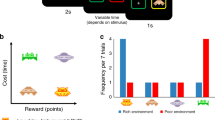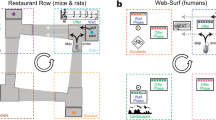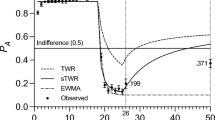Abstract
Although optimal foraging theory predicts that natural selection should favor animal behaviors that maximize long-term rate of gain, behaviors observed in the laboratory tend to be impulsive. In binary-choice experiments, despite the long-term gain of each alternative, animals favor short handling times. Most explanations of this behavior suggest that there is hidden rationality in impulsiveness. Instead, we suggest that simultaneous and mutually exclusive binary-choice encounters are often unnatural and thus immune to the effects of natural selection. Using a simulation of an imperfect forager, we show how a simple strategy (i.e., an intuitive model of animal behavior) that maximizes long-term rate of gain under natural conditions appears to be impulsive under operant laboratory conditions. We then show how the accuracy of this model can be verified in the laboratory by biasing subjects with a short pre-experiment ad libitum high-quality feeding period. We also show a similar behavioral mechanism results in diet preferences that are qualitatively consistent with the digestive rate model of foraging (i.e., foraging under digestive rate constraints).






Similar content being viewed by others
References
Ainslie GW (1974) Impulse control in pigeons. J Exp Anal Behav 21(3):485–489
Ainslie GW (1975) Specious reward: a behavioral theory of impulsiveness and impulse control. Psychol Bull 82(4):463–496
Andrews BW, Passino KM, Waite TA (2004) Foraging theory for decision-making system design: task-type choice. In: Proceedings of the 43rd IEEE conference on decision and control, Nasssau, Bahamas, vol 5, pp 4740–4745. doi:10.1109/CDC.2004.1429539
Bateson M, Kacelnik A (1996) Rate currencies and the foraging starling: the fallacy of the averages revisited. Behav Ecol 7(3):341–352. doi:10.1093/beheco/7.3.341
Bradshaw CM, Szabadi E (1992) Choice between delayed reinforcers in a discrete-trials schedule: the effect of deprivation level. Q J Exp Psychol 44(1):1–16
Charnov EL (1973) Optimal foraging: some theoretical explorations. Dissertation, University of Washington
Charnov EL (1976) Optimal foraging: attack strategy of a mantid. Am Nat 110(971):141–151
Giraldeau L-A, Livoreil B (1998) Game theory and social foraging. In: Dugatkin LA, Reeve HK (eds) Game theory and animal behavior. Oxford University Press, New York, pp 16–37
Giraldeau L-A, Caraco T (2000) Social foraging theory. Princeton University Press, Princeton
Green L, Fisher Jr EB, Perlow S, Sherman L (1981) Preference reversal and self-control: choice as a function of reward amount and delay. Behav Anal Lett 1:43–51
Henly SE, Ostdiek A, Blackwell E, Knutie S, Dunlap AS, Stephens DW (2008) The discounting-by-interruptions hypothesis: model and experiment. Behav Ecol 19(1):154–162. doi:10.1093/beheco/arm110
Hirakawa H (1995) Diet optimization with a nutrient or toxin constraint. Theor Popul Biol 47(3):331–346
Hirakawa H (1997a) Digestion-constrained optimal foraging in generalist mammalian herbivores. Oikos 78(1):37–47
Hirakawa H (1997b) How important is digestive quality? A correction of Verlinden and Wiley’s digestive rate model. Evol Ecol 11(2):249–251
Houston AI, McNamara JM (1985) The choice of two prey types that minimizes the probability of starvation. Behav Ecol Sociobiol 17(2):135–141. doi:10.1007/BF00299245
McDiarmid CF, Rilling ME (1965) Reinforcement delay and reinforcement rate as determinants of schedule preference. Psychon Sci 2:195–196
Monterosso J, Ainslie GW (1999) Beyond discounting: possible experimental models of impulse control. Psychopharmacology 146:339–347
Pulliam HR (1974) On the theory of optimal diets. Am Nat 108(959):59–74
Pyke GH, Pulliam HR, Charnov EL (1977) Optimal foraging: a selective review of theory and tests. Q Rev Biol 52(2):137–154
Quaintenne G, van Gils JA, Bocher P, Dekinga A, Piersma T (2010) Diet selection in a molluscivore shorebird across Western Europe: does it show short- or long-term intake rate-maximization? J Anim Ecol 79(1):53–62. doi:10.1111/j.1365-2656.2009.01608.x
Quijano N, Andrews BW, Passino KM (2006) Foraging theory for multizone temperature control. IEEE Comput Intell Mag 1(4):18–27. doi:10.1109/MCI.2006.329704
Rachlin H, Green L (1972) Commitment, choice and self-control. J Exp Anal Behav 17(1):15–22
Schoener TW (1971) Theory of feeding strategies. Annu Rev Ecol Syst 2:369–404
Siegel E, Rachlin H (1995) Soft commitment: self-control achieved by response persistence. J Exp Anal Behav 64(2):117–128
Sih A, Christensen B (2001) Optimal diet theory: when does it work, and when and why does it fail? Anim Behav 61(2):379–390. doi:10.1006/anbe.2000.1592
Snyderman M (1983) Optimal prey selection: the effects of food deprivation. Behav Anal Lett 3:359–369
Stephens DW (2002) Discrimination, discounting and impulsivity: a role for an informational constraint. Philos Trans R Soc B 357(1427):1527–1537. doi:10.1098/rstb.2002.1062
Stephens DW, Krebs JR (1986) Foraging theory. Princeton University Press, Princeton
Stephens DW, Anderson D (2001) The adaptive value of preference for immediacy: when shortsighted rules have farsighted consequences. Behav Ecol 12(3):330–339
Stephens DW, McLinn CM (2003) Choice and context: test a simple short-term choice rule. Anim Behav 66(1):59–70. doi:10.1006/anbe.2003.2177
Stephens DW, Kerr B, Fernández-Juricic E (2004) Impulsiveness without discounting: the ecological rationality hypothesis. Proc R Soc B 271(1556):2459–2465. doi:10.1098/rspb.2004.2871
van Gils JA, de Rooij SR, van Belle J, van der Meer J, Dekinga A, Piersma T, Drent R (2005) Digestive bottleneck affects foraging decisions in red knots Calidris canutus. I. Prey choice. J Anim Ecol 74(1):105–119. doi:10.1111/j.1365-2656.2004.00903.x
Verlinden C, Wiley RH (1989) The constraints of digestive rate: an alternative model of diet selection. Evol Ecol 3(3):264–272. doi:10.1007/BF02270727
Whelan CJ, Brown JS (2005) Optimal foraging and gut constraints: reconciling two schools of thought. Oikos 110(3):481–496. doi:10.1111/j.0030-1299.2005.13387.x
Acknowledgements
We thank Thomas A. Waite for his helpful insights and instruction and Ian M. Hamilton for his comments on and suggestions for this paper. We are also grateful for the comments and suggestions of two anonymous referees. An anonymous reviewer on a related submission also provided helpful comments that influenced the presentation of this work.
Author information
Authors and Affiliations
Corresponding author
Additional information
Communicated by J. Lindström
Electronic Supplementary Material
Below is the link to the electronic supplementary material.
Rights and permissions
About this article
Cite this article
Pavlic, T.P., Passino, K.M. When rate maximization is impulsive. Behav Ecol Sociobiol 64, 1255–1265 (2010). https://doi.org/10.1007/s00265-010-0940-1
Received:
Revised:
Accepted:
Published:
Issue Date:
DOI: https://doi.org/10.1007/s00265-010-0940-1




